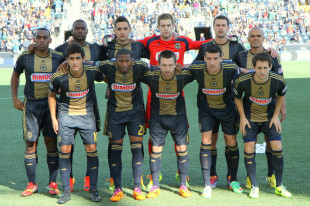Photo: Paul Rudderow
It’s great to be rid of all of the anticipation that came from the Union’s ballyhooed off-season, isn’t it? The preseason took forever to complete, and there was a tendency for the positive to breed worry over whether the changes would actually make a difference.
Two games in, and the positive energy surrounding the team — who appear to be smack dab where you would expect them to be — is refreshing. While they’ve been good, they can be even better if a few things improve.
Four points, two goals
If you were expecting an onslaught of goals because of these changes, then you were disappointed by the lack of DOOPing on Saturday at PPL Park.
A win is a win, and there has been a lot of excellence coming out of the central midfield. Statistically speaking, the Union are currently 4th in the league in short passes per game, and 7th in pass success rate, according to WhoScored.com. The team has little trouble working their way through the opponent’s midfield to enter the final third.
It’s there where things have broken down a bit. The Union sit in the middle of the pack in terms of shots taken (11th) and shots on target (10th). One explanation for this can be formation related. If you look at the shot leaders at the moment, most go with two-striker sets (San Jose, Los Angeles, Real Salt Lake, Houston). That’s often the contrast with a four- versus five-man midfield. The five-man midfield will allow you to maintain more possession, but can you generate the chances with a single forward plus attacking midfielders?
That’s where it stands thus far for Philadelphia. Their possession dominance (51.3%, 7th Place) keeps the opponent on their heels enough to squeak out a 1-0 result.
That leaves the team hoping that no mistakes happen. It came back to bite them in Portland. Without Zac MacMath’s excellent save, Fagundez would have scored the equalizer Saturday on their only real chance generated.
Sustaining possession game into second half
The idea of “possession” as defined by Opta comes from the total number of passes for each team.
As the match progressed, the Union progressively ceded more possession. While this isn’t an uncommon theme in the sport, allowing yourself as a team to get hemmed in and having to withstand long bouts of pressure is a recipe for a big mistake
The team has added height in Austin Berry and Maurice Edu, which is an asset if you need to institute the “park the bus” mentality. But with the players the team has in central midfield and defense, it’s reasonable to believe the Union could maintain possession even into the latter stages when bunkering can be the natural instinct.
Substitutions
This final point certainly contributes to the loss of possession late in the match. (See Eli Pearlman-Storch’s analysis post for details.) The removal of Jack McInerney from the match was an unnecessary withdrawal.
While swapping out McInerney for Antoine Hoppenot preserves the shape, Leo Fernandes had lost traction in the match. The Brazilian’s first period was excellent, but with everything he was asked to do early, he was the weakest link in the match at that moment.
So who do you bring on? The best option available on the bench was Zach Pfeffer, a straight swap with Fernandes. That’s a change that doesn’t alter the shape much, only spells a gassed player.
Remarkably, the Revolution failed to register a shot in the final 30 minutes. I might lay that on Jay Heaps’ doorstep though — they spent so much effort trying to expose forward-turned center back Aaron Wheeler that the Revs lost the plot and failed to do what mattered: generate attempts at goal.
The Union’s overall best option to bring in as that 70th minute sub for Fernades would have been Brian Carroll. Of course, he was ill, and a healthy Carroll starts.
Therein lies the a quandary: Would Carroll operate best as a guy who enters later in the match? You bring off a forward or attacking midfielder for a double pivot to help Edu wrangle the area in front of Berry and Okugo. That pushes Nogueira, a playmaking type, into an advanced position to be an outlet to start the counterattack. It’s something for John Hackworth to consider.



I was championing the “Carroll off the bench late to protect a lead” theme in the preseason, and I hope that Hack gives it a try. Run a 4-4-2 with Casey or 4-3-3 with Leo, own possession, get a lead, then swap in BC in 65th/70th minute to keep it. Edu’s versatility, being able to play several midfield roles depending on who he’s playing with, makes it possible. Take advantage of that.
I’m actually happier with Carroll in there to start. Casey is very good, but I don’t think he presents the problems caused by letting Edu and Nogueira off the leash in central midfield. Look at the way Edu was able to muscle his way around Portland’s 18 yard box. He won’t be able to do that if he has to stay home without Carroll to clean up defensively.
I also think that with the attacking tendencies of Le Toux and Maidana, the final third could get too jumbled.
I think that Carroll will congest our DM, and stifle our transitional game. Edu will have to drop back and provide Carroll with a lateral outlet, negating his freedom to play box-to-box. We have seen it time, and time again.
.
People are undervaluing Casey. He provides a huge presence in the attacking third and that is something that we have been missing. He will take some of the heat off of McInerney as well as provide a real target, in the box.